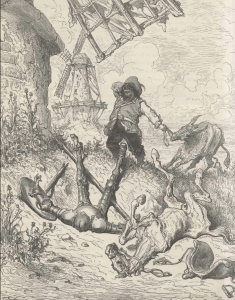Spain
Part one published in 1605; part two published in 1615.
Miguel de Cervantes
Don Quijote de la Mancha
Please contact me (jac@columbia.edu) if you are interested in writing an introduction to this work.
Author Name
Works Cited
If applicable.
Resources
Editions:
Cervantes Saavedra, Miguel de. Don Quijote de la Mancha. Edited by Francisco Rico. Barcelona: Crítica, 1998.
—. Don Quixote. Translated by Edith Grossman. New York: Harper Collins, 2003.
Critical studies:
Allen, John J. “Melisendra’s Mishap in Maese Pedro’s Puppet Show.” MLN 88.2 (1973): 330–35.
Armas, Frederick A. de. “Sancho as a Thief of Time and Art: Ovid’s Fasti and Cervantes’ Don Quixote 2.” Renaissance Quarterly 61.1 (2008): 1–25.
Burningham, Bruce R. “Jongleuresque Dialogue, Radical Theatricality, and Maese Pedro’s Puppet Show.” Cervantes: Bulletin of the Cervantes Society of America 23.1 (2003): 164–200.
Falla, Manuel de. El retablo de Maese Pedro por Manuel de Falla. Adaptación musical y escénica de un episodio del El ingenioso cavallero Don Quixote de la Mancha de Miguel de Cervantes Saavedra. London: J. & W. Chester, 1923.
Fernández, Esther. “Recovering the Intangible Art of Baroque Puppetry: Interview with Jesús Caballero.” Puppetry International 45 (Our Intangible Heritage) (2019): 29–31 and 39.
—. To Embody the Marvelous: The Making of Illusions in Early Modern Spain. Vanderbilt University Press, 2021. [Chapters 4 and 5 deal mainly with Cervantes.]
Fernández Ferreiro, María. La influencia del Quijote en el teatro español contemporáneo: Adaptaciones y recreaciones quijotescas (1900–2010). Alcalá de Henares: Universidad de Alcalá, 2017.
Fernández-Turienzo, Francisco. “La visión cervantina del Quijote,” Anales Cervantinos 20 (1982): 3-27.
Gaylord, Mary Malcolm. “Pulling Strings with Master Peter’s Puppets: Fiction and History in Don Quixote.” Cervantes: Bulletin of the Cervantes Society of America 18.2 (1998): 117–47.
Gillet, Joseph E. “Clavileño: Su fuente directa y sus orígenes primitivos.” Anales Cervantinos 6 (1957): 251–55.
Haley, George. “The Narrator in Don Quijote: Maese Pedro’s Puppet Show.” MLN 80.2 (1965): 145–65.
Henry, Albert. “L’ascendence littéraire de Clavileño.” Romania 90 (1969): 242–57.
Huerta Calvo, Javier. “Don Quijote en la escena contemporánea (variaciones sobre el retablo de Maese Pedro).” In El Quijote desde el siglo XXI, edited by Nicasio Salvador Miguel and Santiago López-Ríos Moreno, 91–100. Alcalá de Henares: Centro de Estudios Cervantinos, 2005.
Jones, Joseph R. “Historical Materials for the Study of the Cabeza Encantada Episode in Don Quijote II.62.” Hispanic Review 47.1 (1979): 87–103.
Kallendorf, Hilaire. “La Inquisición, ¿Por qué deshace la cabeza encantada?” In Actas del XI Coloquio Internacional de la Asociación de Cervantistas, edited by Chul Park, 173–83. Seoul: Universidad Hankuk de Estudios Extranjeros, 2005.
Maestro, Jesús G. “Cervantes y el teatro del Quijote.” Hispania 88.1 (2005): 41–52.
Martínez, Yanisbel V. “Le retable de maître Pierre ou l´histoire que revient.” Puck: La marionette et les autres arts 16 (L’opéra des marionettes) (2009): 79–88.
Nállim, Carlos Orlando. “Clavileño. La tradición en una nueva obra de arte.” In Para leer a Cervantes: Estudios de literatura española Siglo de Oro, vol. 1, edited by Mechora Romanos, Alicia Parodi, and Juan Diego Vila, 83–98. Buenos Aires: Universidad de Buenos Aires, 1999.
Percas de Ponseti, Helena. “Authorial Strings: A Recurrent Metaphor in Don Quijote.” Cervantes: Bulletin of the Cervantes Society of America 1.1–2 (1981): 51–62.
—. Cervantes y su concepto del arte: Estudio crítico de algunos aspectos y episodios del Quijote. Madrid: Gredos, 1975.
Reed, Cory A. “Ludic Revelations in the Enchanted Head Episode in Don Quijote (II, 62).” Cervantes 24.1 (2004): 189–216.
—. Pasiones frías. Secreto y disimulación en el barroco hispano. Madrid: Marcial Pons, 2005.
The above bibliography was supplied by Esther Fernández, Rice University.
Journal:
Cervantes: Bulletin of the Cervantes Society of America.
Further resources:
Castro, Américo. El pensamiento de Cervantes y otros estudios cervantinos. 1925. Ed. José Miranda. Madrid: Trotta, 2002.
Fernández-Morera, Darío. “Cervantes and Economic Theory,” in Paul Cantor and Stephen Cox, eds. Literature and the Economics of Liberty: Spontaneous Order in Culture. Auburn, Ala.: Ludwig von Mises Institute, 2009.
Graf, Eric Clifford. Anatomy of Liberty in Don Quijote de la Mancha: Religion, Feminism, Slavery, Politics, and Economics in the First Modern Novel. Lanham, Maryland: Lexington Books, 2021.
—. A Modern Gloss of Don Quijote: Themes and Schools of Interpretation. 2016. For a summary of the criticism.
Retellings
A reading of the opening of Don Quixote in Spanish by Howard Mancing can be downloaded from First Lines: A Project in Global Diversity (Charles Ross, Purdue University).
Falla, Manuel de. El retablo de Maese Pedro por Manuel de Falla. Adaptación musical y escénica de un episodio del El ingenioso cavallero Don Quixote de la Mancha de Miguel de Cervantes Saavedra. London: J. & W. Chester, 1923.
Puppet Theater
Michael Meschke’s Don Quichotte, after Miguel de Cervantes. Visually inspired by the painting of Gustave Doré. Produced in 1988 by the company of the Stockholm Marionetteatern and performed on international touring. The two roles of Don Quichotte and Dulcinea were created by Michael Meschke and donated to the MAM, Musée des arts de la Marionnette Gadagne, Lyon, France. Don Quichotte, with a huge body and articulated face and fingers, was played by three artists. For more information, including Meschke’s reflection on the creation process and photographs from the production, see the Meschke, Don Quijote page on this site. For Meschke’s website, go to www.michaelmeschke.com.
Eric Clifford Graf’s Discover Don Quijote de la Mancha, a MOOC (“massive open online course”), available in English and Spanish, Universidad Francisco Marroquín, Guatemala.

